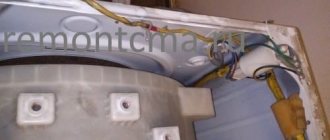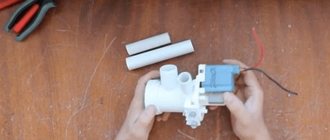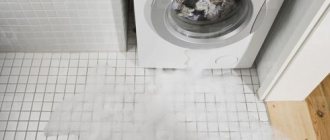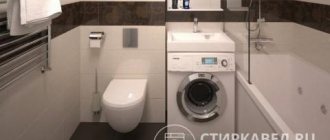Automatic washing machines consume up to 4 kW/h of electricity at peak loads . Therefore, they cannot be plugged into the nearest simple outlet - this may even lead to a fire, or in the best case, the circuit breaker will simply trip and the power will be cut off. How is a washing machine connected to the electrical network ? In what cases is a circuit breaker necessarily installed (and with what parameters)? Is it possible to connect it without grounding and what could this lead to?
Basic diagram of connecting a washing machine to the electrical network. The method for discharging water into the sewer system is also shown schematically here.
Calculation of wire cross-section
The first thing that needs to be calculated is the cross-section of the wire through which the socket/machine that powers the washing machine will be connected. The cross-sectional diameter is selected according to the possible peak load on the electrical network. That is, according to the maximum power consumed by the device (indicated in kilowatts or volt*amps). You can find out the parameters of a particular washing machine directly in the technical documentation.
It is recommended to adhere to the following scheme.
Table 1. Scheme for calculating the cross-section of wires.
| Maximum current consumption | Cross-section of power cable wires (copper), mm | Cross-section of power cable wires (aluminum), in mm |
| Up to 1 kW | 1 | 2.5 |
| Up to 2 kW | 1.5 | 2.5 |
| Up to 3.5 kW | 1.5 | 2.5 |
| Up to 4.4 kW | 2.5 | 4 |
| Up to 5.5 kW | 4 | 6 |
Most household models of washing machines consume from 2 to 3.5 kW . is valid only for a supply voltage of 220 V. Washing machines that require a connection to 380 V are not used for domestic use.
Stranded wire should not be used. It is recommended to buy a single-core one and lay it with a single circuit
Is it possible to use a wire of greater thickness than indicated in the table? Although this will be additional costs, this option is acceptable. The main thing is to lay it through a cable channel, the internal volume of which will be filled to no more than 60% (to ensure normal heat removal, which complies with SNiP standards).
What happens if the wire turns out to be thin?
If the wire is thin, then:
- There is a possibility of overheating of the supplied cable, which will cause its insulation to melt and a short circuit may occur in the future.
- Due to constant overheating, finishing materials will be damaged (even if the wire is mounted in a cable channel, the plaster often becomes covered with cracks, and dark spots appear on the wallpaper).
- Increased load on the terminal connections (in the panel, directly in the socket or machine).
Otherwise, using a wire that is too thin to supply power is a violation of fire safety rules. Active use of such an electrical network can indeed cause a short circuit and subsequent fire.
The most common consequence of using thin wires
Cable brands, power ratings and cross-sections
Modern washing machines consume a lot of power, but manufacturers are trying to reduce this figure as much as possible. The average consumption level reaches 2500 W.
On the back of the device you can easily see what characteristics it has in this regard. The information is often contained in accompanying documents. To determine the cable cross-section, you should use a special table. They are located on specialized sites.
In practice, it is prohibited to use wires for which the following designations are used:
- PUNP.
- APUNP.
If the apartment is equipped only with old two-wire wiring, it is replaced with a three-wire analogue.
The copper three-wire type of wiring is most suitable for making connections. The use of protective additional devices is a mandatory requirement; such connection rules apply under any circumstances.
When a suitable section has been selected, you can safely go to the store to purchase a product with suitable characteristics. The main thing is to choose only manufacturers with a well-deserved reputation.
Availability of grounding
The presence of grounding for a washing machine is a mandatory requirement. This is indicated in the technical documentation and in any other connection instructions. Without grounding, the static voltage generated on the drum of an automatic machine can “break through” to the body, and even to water pipes and taps (especially if the entire water supply is on metal pipes).
Plugs for connecting washing machines most often look like this. The side contacts are just for connecting the ground to a compatible outlet.
Also, static voltage can damage the vulnerable internal components of the washing machine. Most often, control boards “suffer” from it. And repairing such a breakdown can cost half the cost of a new device. And, by the way, connecting the washing machine to the electrical network without grounding is a violation of the warranty conditions. If it fails, even due to a manufacturing defect, the manufacturer has the right to refuse to carry out repairs.
What should be the grounding? The standard currently used is TN-S . In old apartment buildings in the Russian Federation, TN-C . Is it possible to connect the machine to a network with such grounding? In theory, yes, but in practice, the protection will be inadequate. In this situation, the installation of a so-called PEN conductor (often called a “bus”) is required, with its division into channels N (zero) and PE (for grounding). Any electrician can handle this without any problems (it is prohibited to do this on your own, since it requires a partial change in the connection configuration in the switchboard).
As for the cross-sectional diameter of the grounding wire, in most cases 1 mm for copper and 2.5 mm for aluminum are sufficient. And if a regular three-wire wire is installed to connect the power supply to the washing machine, then the cross-section will be the same as that of the supply wiring.
Is it possible to ground the water pipe or radiators? In no case, as this will lead to the spread of static to the entire water supply or heating pipeline in an apartment building. And if the wiring is also installed with a residual current device (RCD), then the grounding connection in such a non-standard way will lead to its automatic operation when the washing machine is turned on.
What to do in private houses where there is no grounding at all? Output it separately for the washing machine (you can also connect a boiler, pumping station, dishwasher to it - these are the devices that consume the most electricity in the house).
Option for grounding in a private house
Socket selection
In 90% of cases, washing machines are installed in the bathroom. And this is a room with high humidity. Therefore, an outlet is required with an increased moisture protection class. It is recommended to adhere to the following scheme:
- The socket is located at a distance of up to 0.6 meters from the bath/shower/sink. The socket housing must comply with IP X5 standards (there will be a different number instead of X - it indicates the class of resistance to dust and dirt penetration inside the housing).
- The socket is located at a distance from 0.7 to 2.4 meters . In this case, the housing must comply with IP X4 standards.
- The socket is located at a distance of over 2.4 meters . You can use a regular household outlet.
Another nuance - you should give preference to sockets with ceramic rather than plastic casings. Even with a short circuit or severe overheating, they do not melt or catch fire - this will be a kind of additional protection.
Symbol of “danger zones”. A socket should not be placed in zone 1
Is it possible to install a “circuit breaker” (circuit breaker) instead of an outlet? In principle, it is possible, but this scheme has several significant disadvantages:
- the machine must be enclosed in an additional sealed housing, which will protect the connection from splashes, moisture, and dirt;
- the machines are installed only externally, they can only be mounted into the wall by covering them with plasterboard; for miniature bathrooms, forming an additional false wall is not an option;
- By default, washing machines have an outlet specifically for the socket; to connect through the “automatic machine,” you have to cut off the plug, which is why the consumer loses the warranty (the manufacturer has the right to refuse service because changes have been made to the design of the device).
So it is recommended to install sockets. The presence of a protective “curtain” on it is not necessary. But you shouldn’t install so-called “smart” sockets (with remote control, measuring wiring temperature). Due to increased currents, control boards, as practice has shown, often fail.
The protective curtain provides virtually no protection from moisture. The main thing is the presence of internal protective membranes that automatically open when the plug is connected
Prices for a waterproof socket with grounding
Waterproof socket with grounding
Permissible load per socket
When choosing an outlet, you should also take into account the permissible peak load on it. Most household models are designed to operate on a 220 V network with a current of 16 A. This means that the maximum power of a washing machine connected to such an outlet should be no higher than 3.5 kW. (220V*16A=3520 W). If the device consumes from 3 kW. and higher , it is definitely recommended to install a socket with a permissible peak load of 25 A. In this case, the risk of overheating of the contacts and the housing itself is eliminated.
One of the common consequences of installing an outlet that is not designed for high loads. The same thing happens if the internal connection at the terminals is not of good quality
Requirements for sockets
To connect washing machines to the network, sockets with a grounding contact are used (they are also called Euro sockets). It is better to use a socket with ceramic fittings.
Important. The use of extension cords, tees and adapters in the electrical circuit is undesirable, as it can lead to a short circuit in case of poor contact, overload or water ingress.
If the socket is installed in the bathroom, then choose a special device with a higher protection class, designed for use in conditions of high humidity.
Is a residual current device (RCD) necessary?
An RCD, in this case a grounding connection is not provided, so the wire is led directly to a grounded plate in the switchboard
The requirement for installing an RCD is not specified in the instructions for the washing machine. But this is due to the fact that in developed countries such devices are installed in the switchboard by default. In the Russian Federation, things are much worse with this. Therefore, it is necessary .
Why is a residual current device needed? Its function is to turn off the power supply when significant “leakage” of electricity occurs in the wiring, namely, electric shock. Accordingly, even if the washing machine breaks down or the insulation of the power cable, which someone takes hold of, is damaged, the RCD will immediately trip and the power will automatically turn off.
RCD connection diagram
Which RCD should be installed? The maximum load is calculated the same as for a socket (also indicated in amperes), but the setting should be no more than 30 mA . Otherwise, there is a risk that the RCD will not operate due to a short-term current leakage.
We recommend reading a related article on this topic about cleaning a washing machine with citric acid to remove scale and dirt. Information about the advantages and disadvantages of citric acid, step-by-step instructions for cleaning a washing machine.
Prices for various types of automatic machines
Difavtomat
Residual current device
When connecting a washing machine to the electrical network, it is necessary to install a protective shutdown system that can de-energize the circuit in a matter of seconds if there is a risk of a short circuit.
The device will operate in cases where the current strength is lower than on the common panel.
This will allow you to disconnect only the bathroom from electricity.
When choosing an RCD, you should consider the type of current it will need to handle. For direct current, A-type devices are used, and for alternating current, AC type devices are used.
If you have no experience in carrying out such work yourself, it is better to call a specialist to connect the washing machine to the electrical network.
Electrical connection diagram
Experienced electricians recommend installing the power supply for connecting the washing machine in a separate group directly from the panel. Additionally, nothing should be connected to this outlet (especially a boiler, pumping station, instantaneous water heater). The cable should be laid through a cable duct; the location of the phase/zero does not matter.
Schematic illustration of connecting a washing machine
If it is not possible to bring a separate power group under the washing machine, then the output is made from the distribution box instead. The most important thing is to ensure reliable connections of wires along the separating groups (the use of terminal blocks is mandatory). And after a test run of the washing machine, you should carefully check whether the wiring connections in the junction box are overheating (for this you can use either an infrared sensor, a thermal imager, or a thermocouple). above 70 degrees occurs anywhere , this indicates errors or shortcomings in the connection.
Another nuance that many do not take into account is the presence of insulation under the washing machine. For this purpose, hardware stores sell special “mats” for the washing machine, which at the same time act as an insulator and partially dampen the vibrations of the body (the machine then “does not jump” when performing a spin cycle at high speeds). And even if water is accidentally spilled on the floor, this will not lead to a short circuit.
The same anti-vibration mat that also acts as an insulator
Advice! Also, you should not use grounding from another contact group of sockets - this can release static discharges into the network and disrupt the operation of other household appliances (especially those that are vulnerable to static: routers, laptops, mobile phones, computers, TVs). Zero should also be displayed separately. This is the most secure connection option.
Typical errors when connecting a washing machine
In old houses, grounding to zero is a common practice. But doing this, of course, is not recommended.
The most common mistakes made when connecting washing machines to the electrical network are the following:
- Connection without grounding. Even if the machine operates in this condition for more than one year, sooner or later static will lead to failure of the control board. In the worst case, when you touch the body of the washing machine, you will receive an electric shock.
- Connection without RCD. Washing machines are directly connected to the water supply. If at some point the pipe breaks or the hose through which water is supplied bursts (and this may be due to a clogged filter), then a short circuit will occur almost instantly, which can lead to a fire. In this situation, the RCD will instantly turn off the power (whereas a conventional machine will only do so when the total load in the electrical network increases). And this is important, since modern washing machines support a delayed start function (for automatic washing using a timer).
- Grounding connection "to zero". When you try to start the washing machine in this case, the protection in the panel room is necessarily triggered and the electricity is completely turned off.
- Connection to an outlet that is not designed for high load. At best, soot will simply appear on it. At worst, it will begin to melt, after which it will simply stop working (due to melting of the contact plates).
- The position of the washing machine was not adjusted before the first start. In this case, the water presence sensor may not work correctly, so water will remain in the drum after washing. It is this that can accumulate static electricity, transferring it to the drum. For the same reason, you can get an electric shock when removing laundry, even if the washing machine is turned off from the outlet.
- After washing, do not unplug the machine from the outlet. Diode bridges, which prevent electrical consumption when turned off, can simply burn out over time. The residual electricity will subsequently go to the control board. Again, the manufacturer also clearly states in the instructions the need to turn off the washing machine when not in use. If it is difficult to get to the outlet, then it is permissible to disconnect the entire power line from the switchboard.
These are just common mistakes.
Video - How to connect a washing machine
How to connect a washing machine - step-by-step instructions
In total, the procedure for connecting the washing machine should be as follows:
Step 1. Lay a 3-wire cable (with grounding) from the switchboard to the installation site of the washing machine.
Laying a 3-core cable
Step 2: Install a compatible outlet. If installation is carried out in the bathroom, then the socket must have a protection class of at least IP X4 or IP X5, depending on the distance to the shower, bathtub, or sink.
Connecting the outlet
Step 3. Connect the RCD (installed in the panel room, not near the outlet).
We connect the RCD
Step 4. Adjusting the position of the washing machine. To do this, just put a building level on top and adjust the position of the legs to set the air capsule to the zero position. Don't forget about the insulating mat.
Correct location of the washing machine
Step 5. Test run the washing machine. Spinning and heating of water are required - these are the functions that result in the highest energy consumption. If the machine is new, then before the first start you should also remove the transport bolts (on the back wall). If this is not done, it will vibrate excessively during operation.
Test run
By the way, the manufacturer must indicate all these recommendations in the instructions.
Those same shipping bolts. They must be removed before the test run.
Prices for the range of washing machines
Washing machine
Video - Connecting and installing washing machines
Capacitor for electric motor
For small motors (<1 kW), the value of the starting capacitor can be determined from the relationship:
C [uF] = (1800 x Pn) / U2
where Pn [W] is the rated power of the motor, U [V] is the supply voltage.
This formula is also suitable for calculating the starting capacitor value for single-phase start-phase motors.
For larger motors (>1kW) a capacitance of around 70uF/1kW is suggested. It is necessary to use starting capacitors with operating voltages of 400..630 V AC.
You can omit the calculations and simply connect a standard motor from the washing machine to 1 phase 220 V through a 7 microfarad capacitor connected between the required terminals. Connect the first power wire to the middle, and the second, depending on the direction of rotation, to one of the capacitor wires. The power drop will be 30% - this is in theory.
The issue of choosing a capacitor is easily resolved. Here are examples of capacitance values for different engine powers.
Pn [W] 90 120 180 250 370 550 750 1100 S [µF] 4 5 6 8 12 16 20 30
Useful: Pulse relay for lighting control - bistable relay circuit
The rotation power in the washing machine is the same in both directions. These are motors with a typical connection for a single-phase motor. The main winding is connected directly to 220 V and a phase winding is connected in parallel with it along with a series-connected capacitor. If you reverse the phase winding wires, the motor will rotate in the other direction, but the power will be slightly less. This circuit works during the spin cycle. The same for slow and fast rotations - the capacitance switches inside the washer from 7 µF to 16 µF. Read more about the capacitor here
Can I connect via an extension cord?
Not all bathrooms have sockets (especially in old Khrushchev-era apartments). They have to connect the washing machine via an extension cord. This option is allowed, but only if the socket, which is the main one, is designed for such loads, and the cross-section of the extension cord has a cross-section of 2.5 mm or more . (only copper is allowed, grounding is also required). The main thing is a reliable connection with a minimum of adapters.
Attention! When connecting via an extension cord, you must use its minimum permissible length. The remaining wire should not be twisted or placed “cue” in one place - this will also lead to its possible overheating.
Extension cord with moisture protection. These aren't cheap. Conventional use is dangerous
In total, when connecting a washing machine to the electrical network, it is necessary to take into account a lot of nuances, starting from the cross-section of the wire through which electricity is supplied, ending with the installation of RCDs, automatic circuit breakers, and grounding terminals. If at least one parameter is not taken into account, then there is a considerable probability of early failure of the equipment without the possibility of its repair under warranty.










